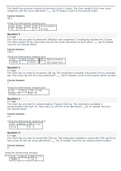Process Improvement & Quality Control
Lecture 1: Introduction
Macro changes and impacts in the environment, causing for new organisational forms & competitive
dynamics, and consequently providing the management with new challenges in this new time.
!
Macro changes & impact
Changes organisations could encounter are digitisation (faster
information transfer, and lower cost of information storage).
The digitisation also in=luences the integration of states and
the opening of markets (globalisation of markets and
dispersion of the value chain).
!
!
!
New organisational forms & competitive dynamics
New forms that we can think of are Rise of global SMEs,
global constellations, and large focused global =irms. This
is resulting in more autonomous and dislocated teams,
with more digitally enabled structures, and more intense
competitive rivalry. Causing for Red Queens: companies
unsuccessfully try to get ahead of the competition.
Implementation strategies to boost their company, which
is practical but only works in theory. In practice
companies have to draw clear distinction between you and
the company. Running hard, but for all purpose standing still
!
Management challenges in A new time
With all the new changes, more diversity and faster
decision making, learning and innovation is required of
companies. The synchronisation and time pacing is
required to be bigger. The lifecycle of industries in
combination with more frequent discontinuities cause for
faster newness and obsolescence. Which inevitably causes
for greater risks.
!
Change process
Two distinct aspects in any improvement or change management situation need to be addressedL
What: need to change (content)
• What needs to be changed to attain improvements
• What would be right? (Reduce waste, no defects, uniform process, work in self-‐managing teams)
• Models can vary but have a general dimension
-‐ Scale: network, single organisation, department, team, individual
-‐ Scope: incremental or radical
!
Relies heavily on the models we have of how organisations and process works
1. Becoming aware of the need to change
2. Diagnosing the change conditions
3. The change process itself and its sub phases
!
How: to bring about that change
Pro-‐active, active, reactive, planned, emergent, collaborative, relationships, norms and values
• What does what in the change process (structural elements?)
• Roles: change leaders, initiator, implementor, facilitator
• Are structural elements included in the change
• Process of change and process steps, phases, stages (H5: 145-‐158; what)
Lecture 1: Introduction
Macro changes and impacts in the environment, causing for new organisational forms & competitive
dynamics, and consequently providing the management with new challenges in this new time.
!
Macro changes & impact
Changes organisations could encounter are digitisation (faster
information transfer, and lower cost of information storage).
The digitisation also in=luences the integration of states and
the opening of markets (globalisation of markets and
dispersion of the value chain).
!
!
!
New organisational forms & competitive dynamics
New forms that we can think of are Rise of global SMEs,
global constellations, and large focused global =irms. This
is resulting in more autonomous and dislocated teams,
with more digitally enabled structures, and more intense
competitive rivalry. Causing for Red Queens: companies
unsuccessfully try to get ahead of the competition.
Implementation strategies to boost their company, which
is practical but only works in theory. In practice
companies have to draw clear distinction between you and
the company. Running hard, but for all purpose standing still
!
Management challenges in A new time
With all the new changes, more diversity and faster
decision making, learning and innovation is required of
companies. The synchronisation and time pacing is
required to be bigger. The lifecycle of industries in
combination with more frequent discontinuities cause for
faster newness and obsolescence. Which inevitably causes
for greater risks.
!
Change process
Two distinct aspects in any improvement or change management situation need to be addressedL
What: need to change (content)
• What needs to be changed to attain improvements
• What would be right? (Reduce waste, no defects, uniform process, work in self-‐managing teams)
• Models can vary but have a general dimension
-‐ Scale: network, single organisation, department, team, individual
-‐ Scope: incremental or radical
!
Relies heavily on the models we have of how organisations and process works
1. Becoming aware of the need to change
2. Diagnosing the change conditions
3. The change process itself and its sub phases
!
How: to bring about that change
Pro-‐active, active, reactive, planned, emergent, collaborative, relationships, norms and values
• What does what in the change process (structural elements?)
• Roles: change leaders, initiator, implementor, facilitator
• Are structural elements included in the change
• Process of change and process steps, phases, stages (H5: 145-‐158; what)










